Improved Fluorescence and Gain Characteristics of Er-Doped Optical Fiber with PbS Nanomaterials Co-Doping
Abstract
1. Introduction
2. Theoretical Calculations
2.1. Local Structural Models of PbS-Doped Fiber Materials
2.2. Local Structural Models of PbS/Er Co-Doped Fiber Materials
2.3. Frontier Molecular Orbital
2.4. Energy Level
3. Experimental Section and Results
3.1. Fiber Preparation
3.2. Structural Properties
3.3. Fluorescence Properties
3.4. Gain Properties
4. Conclusions
Author Contributions
Funding
Institutional Review Board Statement
Informed Consent Statement
Data Availability Statement
Acknowledgments
Conflicts of Interest
References
- Mears, R.J.; Reekie, L.; Poole, S.B.; Payne, D.N. Low-threshold tunable CW and Q-switched fibre laser operating at 1.55 μm. Electron. Lett. 1986, 3, 159–160. [Google Scholar] [CrossRef]
- Lin, H.; Feng, Y.; Feng, Y.; Barua, P.; Sahu, J.K.; Nilsson, J. 656 W Er-doped, Yb-free large-core fiber laser. Opt. Lett. 2018, 43, 3080–3083. [Google Scholar] [CrossRef]
- Zhang, J.; Fromzel, V.; Dubinskii, M. Resonantly cladding-pumped Yb-free Er-doped LMA fiber laser with record high power and efficiency. Opt. Express 2011, 19, 5574–5578. [Google Scholar] [CrossRef] [PubMed]
- Zhai, Z.; Halder, A.; Nunez-Velazquez, M.; Sahu, J.K. Temperature-dependent study on L-band EDFA characteristics pumped at 980 nm and 1480 nm in phosphorus and aluminum-rich erbium-doped dilica fibers. J. Lightwave Technol. 2022, 40, 4819–4824. [Google Scholar] [CrossRef]
- Giles, C.R.; Desurvire, E. Modeling erbium-doped fiber amplifiers. J. Lightwave Technol. 1991, 9, 271–283. [Google Scholar] [CrossRef]
- Matniyaz, T.; Kong, F.; Kalichevsky-Dong, M.T.; Dong, L. 302 W single-mode power from an Er/Yb fiber MOPA. Opt. Lett. 2020, 45, 2910–2913. [Google Scholar] [CrossRef]
- Baker, C.C.; Burdett, A.; Friebele, E.J.; Rhonehouse, D.L.; Kim, W.; Sanghera, J. Rare earth co-doping for increased efficiency of resonantly pumped Er-fiber lasers. Opt. Mater. Express 2019, 9, 1041–1048. [Google Scholar] [CrossRef]
- Chen, Y.; Lou, Y.; Gu, Z.; Qiu, Q.; He, L.; Li, W.; Yin, X.; Zhao, X.; Liu, S.; Peng, J.; et al. Extending the L-band amplification to 1623 nm using Er/Yb/P co-doped phosphosilicate fiber. Opt. Lett. 2021, 46, 5834–5837. [Google Scholar] [CrossRef]
- Shao, C.; Wang, F.; Jiao, Y.; Wang, S.; Wang, X.; Yu, C.; Hu, L. Relationship between glass structure and spectroscopic properties in Er3+/Yb3+/Al3+/P5+-doped silica glasses. Opt. Mater. Express 2020, 10, 1169–1181. [Google Scholar] [CrossRef]
- Barnes, W.L.; Laming, R.I.; Tarbox, E.J.; Morkel, P.R. Absorption and emission cross section of Er3+ doped silica fibers. IEEE J. Quantum Elect. 1991, 27, 1004–1010. [Google Scholar] [CrossRef]
- Jain, S.; Sakamoto, T.; Jung, Y.; Davidson, I.A.; Barua, P.; Hayes, J.R.; Shibahara, K.; Mizuno, T.; Miyamoto, Y.; Nakajima, K.; et al. High spatial-density, cladding-pumped 6-mode 7-core fiber amplifier for C-band operation. Opt. Express 2021, 29, 30675–30681. [Google Scholar] [CrossRef] [PubMed]
- Abedin, K.S.; Yan, M.F.; Taunay, T.F.; Zhu, B.; Monberg, E.M.; DiGiovanni, D.J. State-of-the-art multicore fiber amplifiers for space division multiplexing. Opt. Fiber Technol. 2017, 35, 64–71. [Google Scholar] [CrossRef]
- Likhachev, M.E.; Bubnov, M.M.; Zotov, K.V.; Lipatov, D.S.; Yashkov, M.V.; Guryanov, A.N. Effect of the AlPO4 join on the pump-to-signal conversion efficiency in heavily Er-doped fibers. Opt. Lett. 2009, 34, 3355–3357. [Google Scholar] [CrossRef]
- Moreels, I.; Justo, Y.; De Geyter, B.; Haustraete, K.; Martins, J.C.; Hens, Z. Size-tunable, bright, and stable PbS quantum dots: A surface chemistry study. ACS Nano 2011, 5, 2004–2012. [Google Scholar] [CrossRef] [PubMed]
- Silva, R.S.; Qu, F.; Alcalde, A.M.; Dantas, N.O. Atomic force microscopy and optical characterization of PbS quantum dots grown in glass matrix. Microelectron. J. 2003, 34, 647–649. [Google Scholar] [CrossRef]
- Zhang, X.; Lin, S.; Lin, T.; Zhang, P.; Xu, J.; Xu, L.; Chen, K. Improved sensitization efficiency in Er3+ ions and SnO2 nanocrystals co-doped silica thin films. Phys. Chem. Chem. Phys. 2015, 17, 11974–11980. [Google Scholar] [CrossRef]
- Zhang, X.W.; Lin, T.; Zhang, P.; Song, H.C.; Jin, H.; Xu, J.; Xu, J.; Wang, P.J.; Niu, K.Y.; Chen, K.J. Tunable quantum dot arrays as efficient sensitizers for enhanced near-infrared electroluminescence of erbium ions. Nanoscale 2018, 10, 4138–4146. [Google Scholar] [CrossRef]
- Wang, W.; Xiao, Y.; Zhou, B.; Xu, S.; Zhang, Q. Quantum-dots-precipitated rare-earth-doped glass for ultra-broadband mid-infrared emissions. J. Am. Ceram. Soc. 2019, 102, 1560–1565. [Google Scholar] [CrossRef]
- Zhou, Y.; Zhang, Z.; Jiang, W.; Gao, P.; Zhang, X.; Zhang, W.; Zhang, Y.; Qyyum, A.; Li, X.; Liao, M.; et al. A passively mode-locked thulium-doped fiber laser based on a D-shaped fiber deposited with PbS nanoparticles. J. Mater. Chem. C 2019, 7, 11215–11219. [Google Scholar] [CrossRef]
- Haram, S.K.; Kshirsagar, A.; Gujarathi, Y.D.; Ingole, P.P.; Nene, O.A.; Markad, G.B.; Nanavati, S.P. Quantum confinement in CdTe quantum dots: Investigation through cyclic voltammetry supported by density functional theory (DFT). J. Phys. Chem. C 2011, 115, 6243–6249. [Google Scholar] [CrossRef]
- Jaworski, A.; Stevensson, B.; Edén, M. The bearings from rare-earth (RE= La, Lu, Sc, Y) cations on the oxygen environments in aluminosilicate glasses: A study by solid-state 17O NMR, molecular dynamics simulations, and DFT calculations. J. Phys. Chem. C 2016, 120, 13181–13198. [Google Scholar] [CrossRef]
- Pan, X.; Dong, Y.; Zheng, J.; Wen, J.; Pang, F.; Chen, Z.; Shang, Y.; Wang, T. Enhanced FBG temperature sensitivity in PbS-doped silica optical fiber. J. Lightwave Technol. 2019, 37, 4902–4907. [Google Scholar] [CrossRef]
- Ponsoda, J.J.M.; Norin, L.; Ye, C.; Bosund, M.; Söderlund, M.J.; Tervonen, A.; Honkanen, S. Ytterbium-doped fibers fabricated with atomic layer deposition method. Opt. Express 2012, 20, 25085–25095. [Google Scholar] [CrossRef] [PubMed]
- Wang, T.Y.; Wen, J.X.; Luo, W.Y.; Xiao, Z.Y.; Chen, Z.Y. Influences of irradiation on network microstructure of low water peak optical fiber material. J. Non-Cryst. Solids 2010, 356, 1332–1336. [Google Scholar] [CrossRef]
- Lopez, N.; Vitiello, M.; Illas, F.; Pacchioni, G. Interaction of H2 with strained rings at the silica surface from ab initio calculations. J. Non-Cryst. Solids 2000, 271, 56–63. [Google Scholar] [CrossRef]
- Sun, X.; Wen, J.; Guo, Q.; Pang, F.; Chen, Z.; Luo, Y.; Peng, G.D.; Wang, T. Fluorescence properties and energy level structure of Ce-doped silica fiber materials. Opt. Mater. Express 2017, 7, 751–759. [Google Scholar] [CrossRef]
- Sun, S.; Jia, B.; Han, L.; Liu, G.; Gao, C.; Zhang, L.; Wang, J.; Yang, C.; Lu, P. Influence of ring structures on optical absorption of trivalent ytterbium in Yb-doped silica fiber. J. Lumin. 2021, 239, 118370. [Google Scholar] [CrossRef]
- Yang, Y.; Homma, O.; Urata, S.; Ono, M.; Mauro, J.C. Topological pruning enables ultra-low Rayleigh scattering in pressure-quenched silica glass. NPJ Comput. Mater. 2020, 6, 1–8. [Google Scholar] [CrossRef]
- Weidman, M.C. Controlling Nanomaterial Self-Assembly for Next Generation Optoelectronic Applications; Massachusetts Institute of Technology: Cambridge, MA, USA, 2016; Chapter 1; pp. 20–21. [Google Scholar]
- Smith, A.M.; Nie, S. Semiconductor nanocrystals: Structure, properties, and band gap engineering. Acc. Chem. Res. 2010, 43, 190–200. [Google Scholar] [CrossRef]
- Da Silva, J.L.; Ganduglia-Pirovano, M.V.; Sauer, J.; Bayer, V.; Kresse, G. Hybrid functionals applied to rare-earth oxides: The example of ceria. Phys. Rev. B 2007, 75, 045121. [Google Scholar] [CrossRef]
- Dong, Y.; Wen, J.; Pang, F.; Chen, Z.; Wang, J.; Luo, Y.; Peng, G.; Wang, T. Optical properties of PbS-doped silica optical fiber materials based on atomic layer deposition. Appl. Surf. Sci. 2014, 320, 372–378. [Google Scholar] [CrossRef]
- Maron, L.; Eisenstein, O. Do f electrons play a role in the lanthanide-ligand bonds? A DFT study of Ln(NR2)3; R= H, SiH3. J. Phys. Chem. A 2000, 104, 7140–7143. [Google Scholar] [CrossRef]
- Atanasov, M.; Daul, C.; Güdel, H.U.; Wesolowski, T.A.; Zbiri, M. Ground states, excited states, and metal-ligand bonding in rare earth hexachloro complexes: A DFT-based ligand field study. Inorg. Chem. 2005, 44, 2954–2963. [Google Scholar] [CrossRef] [PubMed][Green Version]
- Shang, Y.; Wen, J.; Dong, Y.; Zhan, H.; Luo, Y.; Peng, G.D.; Zhang, X.; Pang, F.; Chen, Z.; Wang, T. Luminescence properties of PbS quantum-dot-doped silica optical fibre produced via atomic layer deposition. J. Lumin. 2017, 187, 201–204. [Google Scholar] [CrossRef]
- Sun, X.; Wen, J.; Jiang, D.; Pang, F.; Chen, Z.; Luo, Y.; Peng, G.; Wang, T. Absorption and microstructure properties calculated of Er-doped silica fiber based on DFT theory. In Proceedings of the Asia Communications and Photonics Conference (ACP), Wuhan, China, 2–5 November 2016. AF2A-128. [Google Scholar]
- Wang, J.; Brocklesby, W.S.; Lincoln, J.R.; Townsend, J.E.; Payne, D.N. Local structures of rare-earth ions in glasses: The ‘crystal-chemistry’approach. J. Non-Cryst. Solids 1993, 163, 261–267. [Google Scholar] [CrossRef]
- Haruna, T.; Iihara, J.; Yamaguchi, K.; Saito, Y.; Ishikawa, S.; Onishi, M.; Murata, T. Local structure analyses around Er3+ in Er-doped fiber with Al co-doping. Opt. Express 2006, 14, 11036–11042. [Google Scholar] [CrossRef]
- Tang, F.Z.; McNamara, P.; Barton, G.W.; Ringer, S.P. Nanoscale characterization of silica soots and aluminium solution doping in optical fibre fabrication. J. Non-Cryst. Solids 2006, 352, 3799–3807. [Google Scholar] [CrossRef]
- Peng, M.; Zhang, N.; Wondraczek, L.; Qiu, J.; Yang, Z.; Zhang, Q. Ultrabroad NIR luminescence and energy transfer in Bi and Er/Bi co-doped germanate glasses. Opt. Express 2011, 19, 20799–20807. [Google Scholar] [CrossRef]
- Borrelli, N.F.; Smith, D.W. Quantum confinement of PbS microcrystals in glass. J. Non-Cryst. Solids 1994, 180, 25–31. [Google Scholar] [CrossRef]
- Yue, F.; Tomm, J.W.; Kruschke, D.; Glas, P.; Bzheumikhov, K.A.; Margushev, Z.C. PbS: Glass as broad-bandwidth near-infrared light source material. Opt. Express 2013, 21, 2287–2296. [Google Scholar] [CrossRef]
- Wang, J.S.; Ullrich, B.; Das, A.; Wai, C.M.; Brown, G.J.; Dass, C.K.; Hendrickson, J.R. Luminescence studies for energy transfer of lead sulfide QD films. RSC Adv. 2016, 6, 48651. [Google Scholar] [CrossRef]

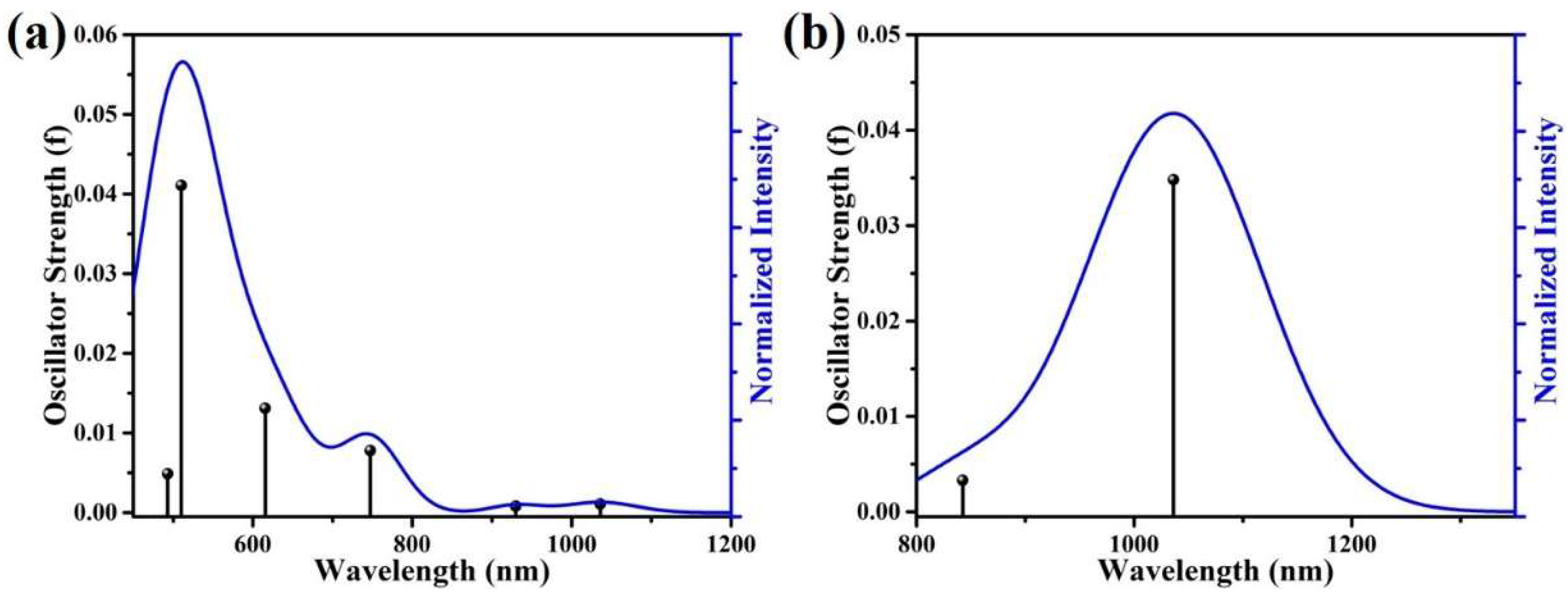
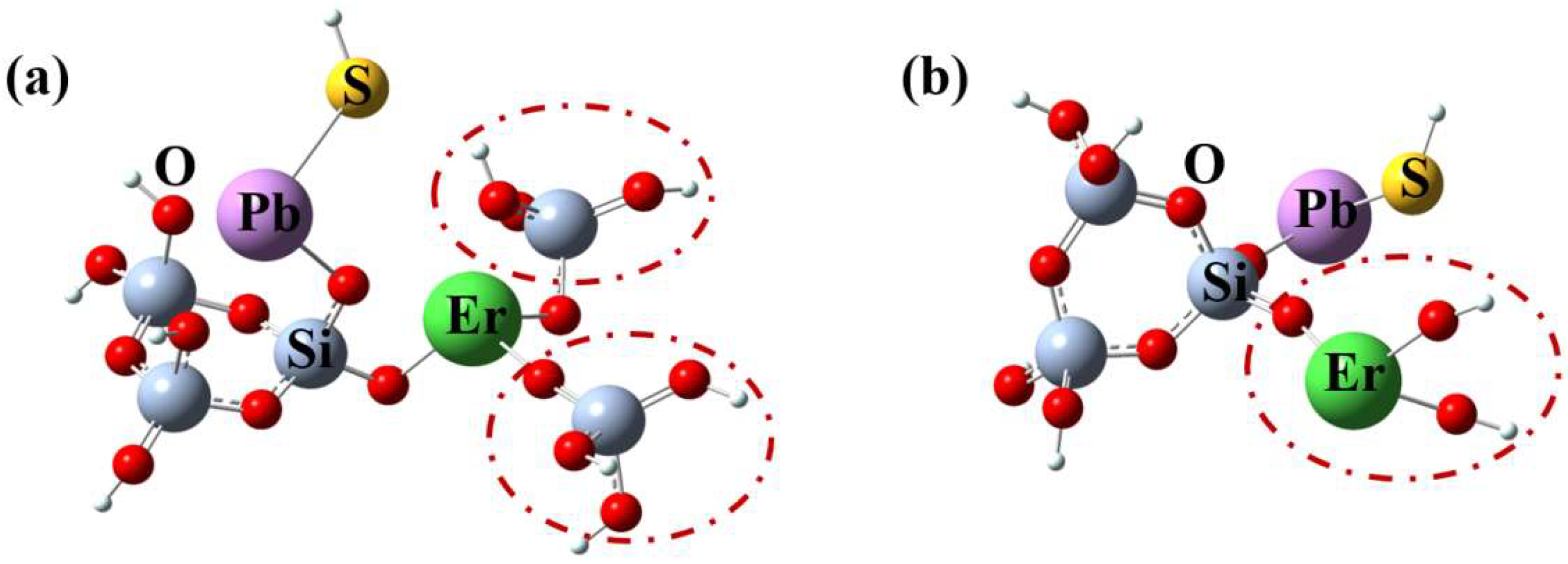
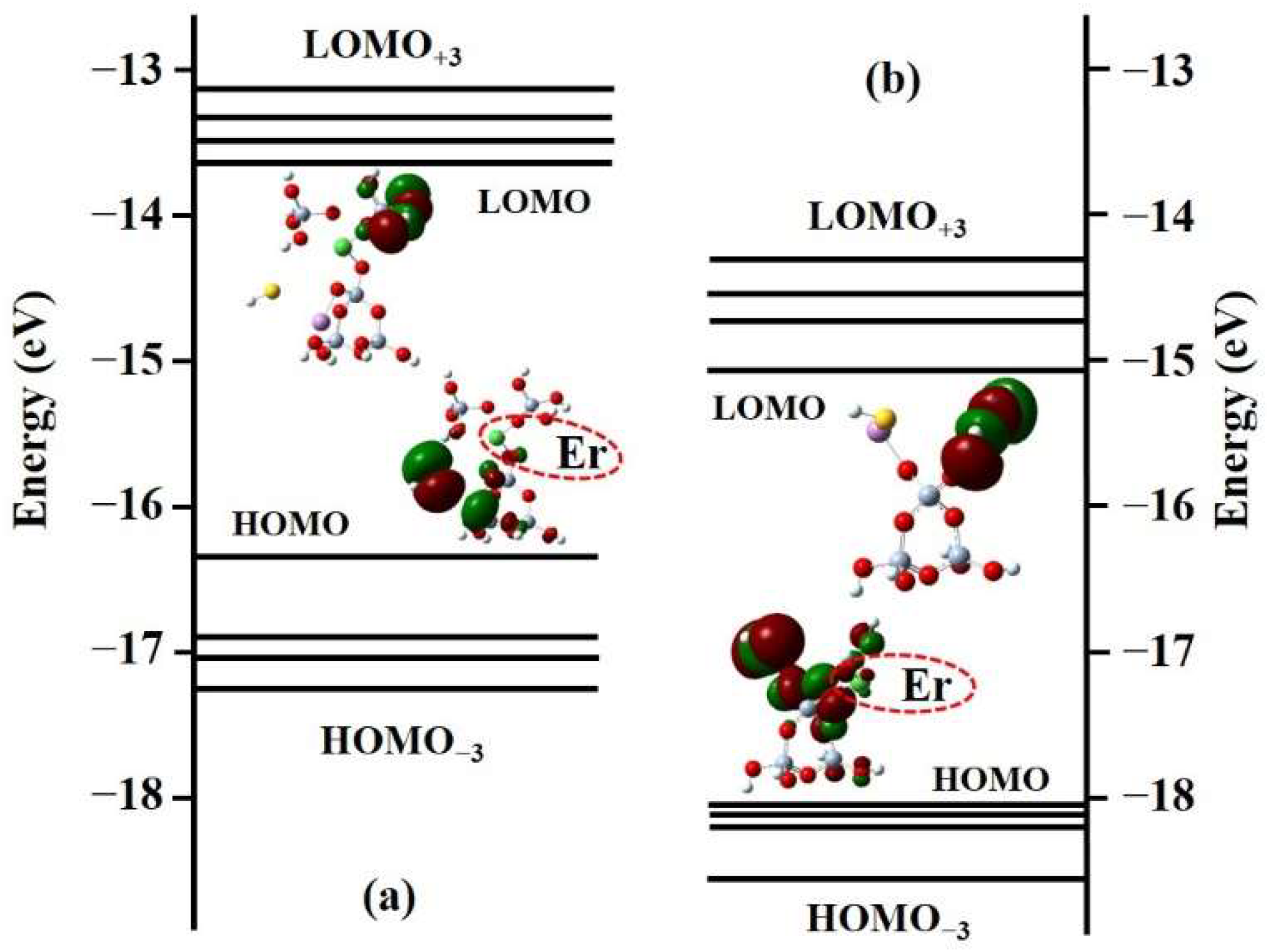
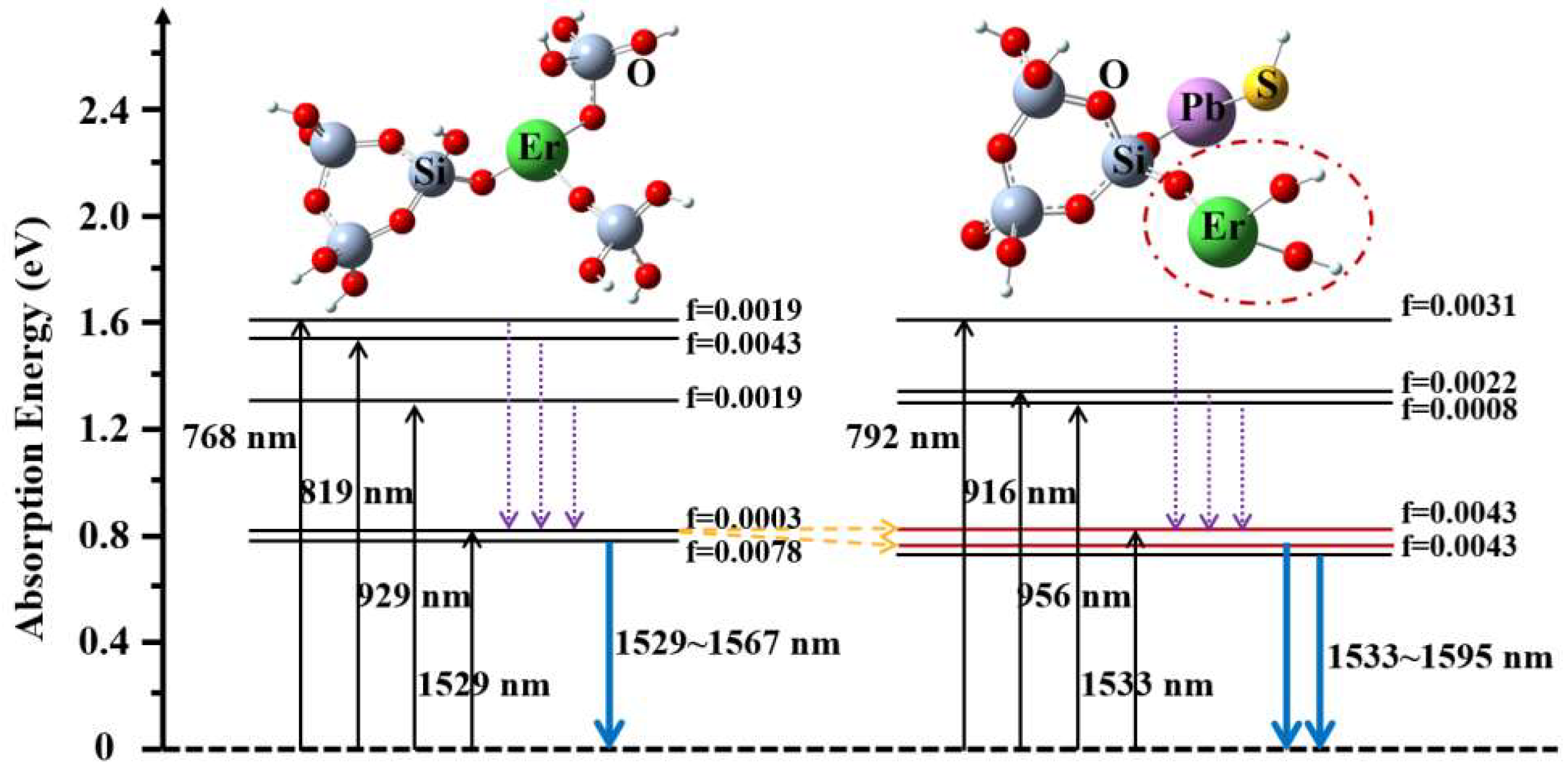
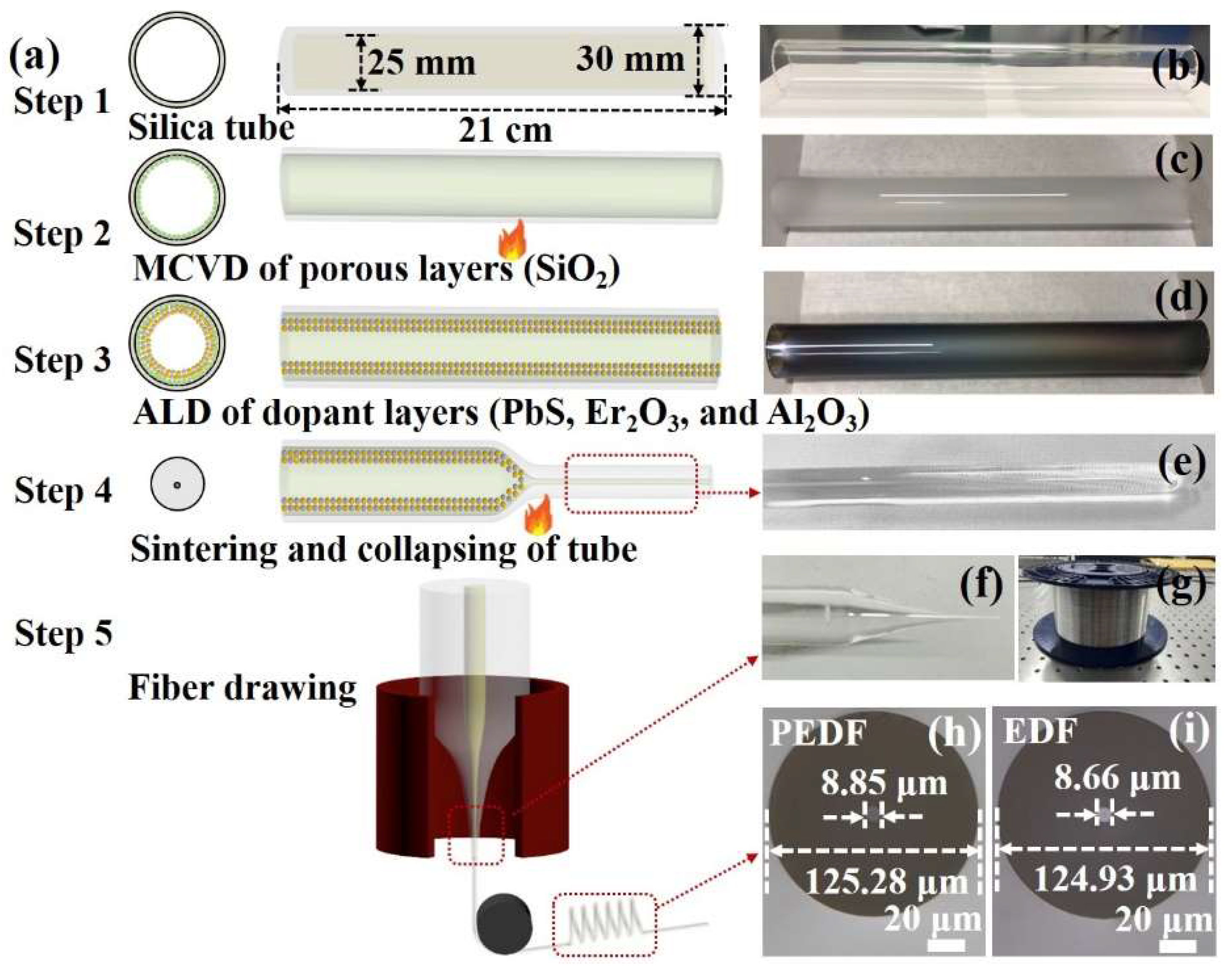



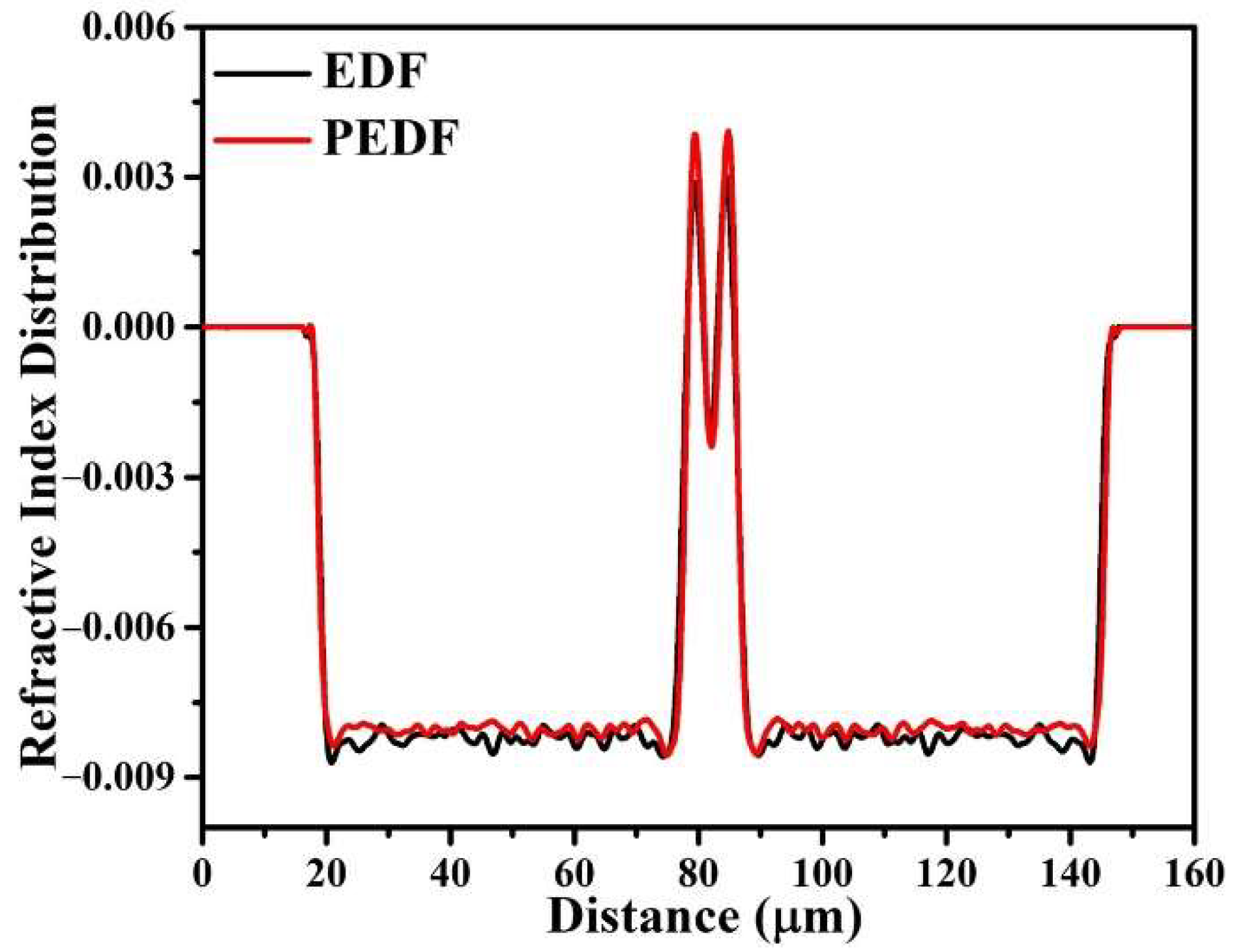
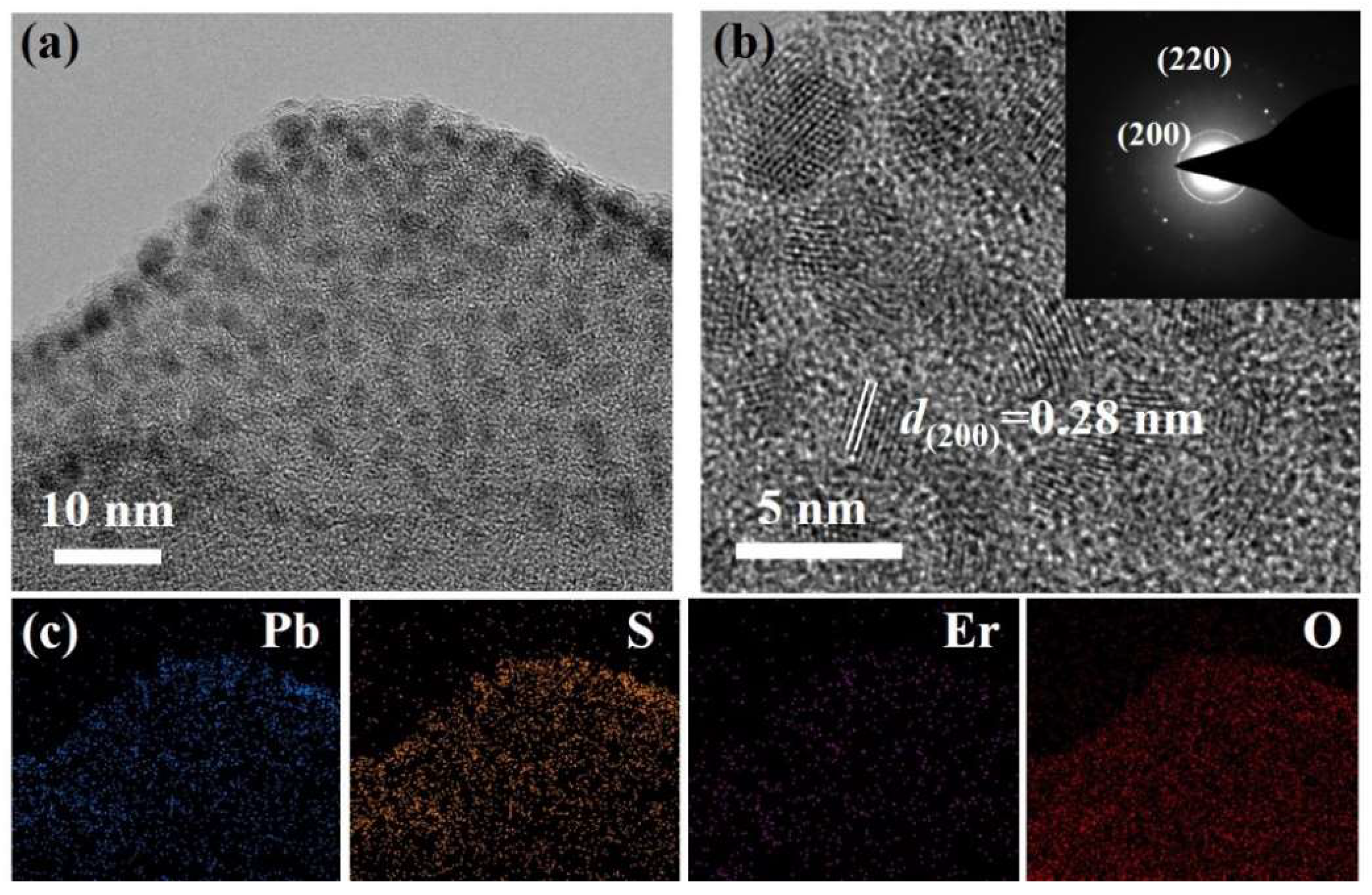
| Microstructures | Model (a) | Model (b) | Model (c) |
|---|---|---|---|
| Energy (a.u.) | 7.3141 | 6.0843 | 7.3265 |
| Electronic Transition | Excitation Energies (eV) | Oscillator Strength (f) | Wavelength (nm) |
|---|---|---|---|
| S0–S1 | 0.7878 | 0.0002 | 1573.83 |
| S0–S2 | 1.2934 | 0.0009 | 958.62 |
| S0–S3 | 1.3664 | 0.0005 | 907.39 |
| S0–S4 | 1.5441 | 0.0017 | 802.93 |
| S0–S5 | 1.8694 | 0.0009 | 663.24 |
| Electronic Transition | Excitation Energies (eV) | Oscillator Strength (f) | Wavelength (nm) |
|---|---|---|---|
| S0–S1 | 0.7770 | 0.0043 | 1595.77 |
| S0–S2 | 0.8086 | 0.0043 | 1533.41 |
| S0–S3 | 1.2842 | 0.0008 | 965.48 |
| S0–S4 | 1.3535 | 0.0022 | 916.05 |
| S0–S5 | 1.5661 | 0.0031 | 791.67 |
| S0–S6 | 1.9044 | 0.0016 | 651.03 |
| Samples | O (wt.%) | Ge (wt.%) | Er (wt.%) | Al (wt.%) | Si (wt.%) | Pb (wt.%) |
|---|---|---|---|---|---|---|
| EDF | 42.96 | 6.85 | 0.12 | 0.61 | 49.46 | 0 |
| PEDF | 42.69 | 6.99 | 0.12 | 0.62 | 48.59 | 0.98 |
Publisher’s Note: MDPI stays neutral with regard to jurisdictional claims in published maps and institutional affiliations. |
© 2022 by the authors. Licensee MDPI, Basel, Switzerland. This article is an open access article distributed under the terms and conditions of the Creative Commons Attribution (CC BY) license (https://creativecommons.org/licenses/by/4.0/).
Share and Cite
Pan, X.; Dong, Y.; Wen, J.; Shang, Y.; Zhang, X.; Huang, Y.; Pang, F.; Wang, T. Improved Fluorescence and Gain Characteristics of Er-Doped Optical Fiber with PbS Nanomaterials Co-Doping. Materials 2022, 15, 6090. https://doi.org/10.3390/ma15176090
Pan X, Dong Y, Wen J, Shang Y, Zhang X, Huang Y, Pang F, Wang T. Improved Fluorescence and Gain Characteristics of Er-Doped Optical Fiber with PbS Nanomaterials Co-Doping. Materials. 2022; 15(17):6090. https://doi.org/10.3390/ma15176090
Chicago/Turabian StylePan, Xiangping, Yanhua Dong, Jianxiang Wen, Yana Shang, Xiaobei Zhang, Yi Huang, Fufei Pang, and Tingyun Wang. 2022. "Improved Fluorescence and Gain Characteristics of Er-Doped Optical Fiber with PbS Nanomaterials Co-Doping" Materials 15, no. 17: 6090. https://doi.org/10.3390/ma15176090
APA StylePan, X., Dong, Y., Wen, J., Shang, Y., Zhang, X., Huang, Y., Pang, F., & Wang, T. (2022). Improved Fluorescence and Gain Characteristics of Er-Doped Optical Fiber with PbS Nanomaterials Co-Doping. Materials, 15(17), 6090. https://doi.org/10.3390/ma15176090







